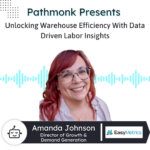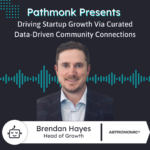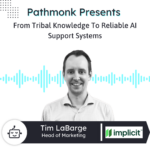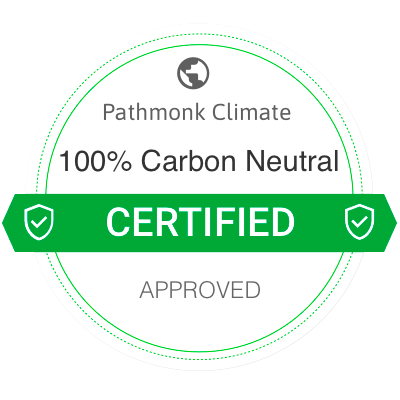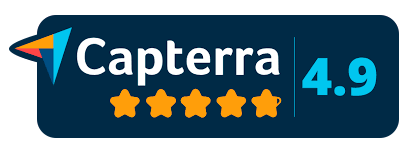
Introduction
In this episode, Rick speaks with Himanshu Saxena, founder of First Principles, a consultancy and fellowship program focused on helping founders sharpen their messaging through simplicity and structured storytelling.
Himanshu shares lessons from building and scaling products across multiple industries and explains why most startups fail to communicate value clearly. He breaks down how frameworks like April Dunford’s positioning and Donald Miller’s story loop guide effective copy and website strategy, especially for technical founders.
Listeners gain insights into using conversations, communities, and AI tools to refine messaging, test content, and build stronger distribution channels.
Increase +180%
leads
demos
sales
bookings
from your website with AI
Get more conversions from your existing website traffic delivering personalized experiences.

Rick: Pathmonk is the AI for website convergence. With increasing online competition, over 98% of website visitors simply don’t convert. So the ability to successfully show your value proposition and support visitors in the buying journey separates you from the competition Online. Pathmonk qualifies and converts leads on your website by figuring out where they are in the buying journey and influencing them in key decision moments, relevant micro experiences like case studies, intro videos, and much more.
Stay relevant to your visitors and increase conversions by 50% by adding Pathmonk to your website in seconds. Letting the AI do all the work and increase conversions while you keep doing marketing as usual. Check us out on Pathmonk.com. Alright everyone, welcome to today’s episode of Pathmonk Presents.
Today we are joined by Iman is the founder of First Principles. Hemanchu, welcome to the show.
Thank you so much, Rick. Thank you so much for having me. Really excited.
Rick: likewise. We were just, warming up, just before hitting record and, we were talking about first principles and a few things that you got going, but Iman, you in your own words, what’s the heart of what your company does, what you guys are doing, and how would you describe it to someone new like our audience?
Himanshu Saxena: Yeah, I think I’ve got a couple of things on my plate. first principles is more of a passion project for me. I started out as a teenager running a small artist management agency. This goes way back, when I was in high school, which eventually turned into a record label. and I sold it off when I was 19.
that was my first time when I was building something and I realized that why it’s important to have a product or a service. It’s equally important how you talk about it, how you distribute, The, kind of words you use, your copy and messaging, all of them become really important. And over the years I’ve built, and scaled multiple ventures across ai, SaaS.
I’ve worked in FinTech, I’ve worked in EdTech, and I’ve worked with, e-commerce. so a couple of e a, lot of exposure when it comes to different fields, different domains. But one thing that has been common is. My struggle to find out the right set of messaging or the right copy that could work with, first Principles started out as a way to do that.
with first principles. I’m offering fellowships to. People who are in school, and colleges, like if you’re interested in learning about, different schools of thoughts around storytelling, different practices, different frameworks, different structures, which probably we can again, translate and, use for SaaS marketing or B2B marketing or B2C marketing.
So that’s the whole agenda there. I’ve been doing that for a year now, and I think, With, with whole, with, this whole chat, GPT and AI coming into the picture, it’s becoming really easy to create a product, the barrier to entry to be a founder or to become a creator, or to become, or to run, or to create your own tool. it’s, pretty low. So the differentiator is going to be how you market. And I think, of course, unk, would, would want to get into a detailed conversation about how you guys do that. But your GTM will. We’ll be, if not less, but equally or even more important than the product.
So with first principles, I’m trying to enable that work with a bunch of students, interns, and see if we can create a great content bank around storytelling, which all of us could benefit out of.
Rick: That’s pretty cool. And also sounds like, you’re passing it on in a way, working with students. You were a student yourself.
You had this idea, you’re a creative type, so you got going and you actually acted on it, and now you’re helping them, do something similar. So that’s pretty cool. Now, when it comes to, to first Principles, is the only student you work with, or do you have, companies and industries you work with?
Or is it specific? Let’s say to
Himanshu Saxena: there is a consulting arm to it. of course the goal is to be able to take these services to, organizations who need it. So I’m working with a couple of organizations right now. one of them is out of the blue. It’s similar to that of a triple wheel.
I’m sure you would’ve heard about it. In the e-commerce space. And then I’m also working with, so previously I was working full-time with this, organization, this company called Dev Dynamics. They’re a developer productivity platform. So I still continue to work with them in whatever capacity I can.
so that’s more into, develop a productivity space. But yeah, at one point or at one time, I try to be associated with, just one brand, because that really allows me to dive deep into their domain. And see what is the set of messaging or what kind of content is working for them.
Because it’s a long term cycle, right? The feedback loop is long. if the blocks that you’re doing or the hero section that you have changed on the website, is it gonna work or not? So yeah, that’s where I am right now.
Rick: Very good, What would you say, Iman, what’s the core problem that you would help this company solve, if you will, and what can they expect when they come to you?
Whether it’s, to you personally or, for first principles and, the people you’re training. What do you say is the one problem that they have that you see? Maybe there’s a pattern there or something that you help ’em solve.
Himanshu Saxena: The one problem is that I think we have forgotten the art of staying simple, I think through our schooling.
And then the way we have grown up, you grow up to admire a certain language. You, admire a certain author or the way books are written. But what you read on an editorial piece, like on a book or on a website, that’s not how you and me talk. if whatever we are talking right now, if this was published, it would be a totally different language altogether, right?
So we have grown up to writing our content that way. So we have forgotten the art of being simple. That’s number one. Second thing is, I think just building upon that, and this is something what I said earlier, these days, a lot of founders or a lot of startups, you’ll find these people. So these are all people who are probably techies.
the product people, tech people who came together, who built something. Now they really struggle to translate their offering in a language that people can understand. So yeah, I think that’s one thing that I’m solving for, and this one thing, which I always say to my friends and people that I’m working with, that simple is the new smart.
Like the more simple you can be, the smarter your content is from.
Rick: That’s, I like it. I like it. That’s another one that I heard recently, which really stuck with me. That’s the term complexity. that’s, the merging of complexity, which is needed for many things, right? But also simplicity.
And it’s like complexity is being able to condense or synthesize if you will, something complex into something simple, which is really, hard. So along the lines of, of what you said, I think it’s, that’s what we need to strive for. So I definitely agree.
Iman, you what’s the what, something you learned, along the way when it comes to. to messaging to the importance of even with the companies you’re working now, right? to the importance of having a great, converting website. and maybe even if you have at the top of your head, maybe any tools, any methods, any frameworks, as I mentioned earlier, that you rely on to be able to make things simple so that people can, get what they want, get their goals.
Himanshu Saxena: I think there are a couple of people that have inspired me in this journey. One is, I think if you’re in this space, I’m sure you would’ve heard about, heard of, you would’ve heard of April Dunford. and she really talks about how you’re supposed to nail your messaging.
one thing that she always talks about it, that you have to start with, always start with the problem and not the product. And this is, This is a classic rookie mistake, which a lot of first time founders or a, small startup with no marketing people per, to say would do.
so what happens is you created a product, you like the product so much that you end up talking about that your website describes 10 different features, but majority of the time, we are not buying features.
Nobody’s buying an iPhone because it has. X GB of RAM or Y GB of storage. You’re buying it for the class, you’re buying it for how you feel when you hold it. you’re not buying a SaaS product because it helps you with, so of course it’s gonna help you with something, but you’re buying more because.
It’s gonna make your life easier. So a lot of times we miss on addressing that part, that how is it making your life easier?
there’s another person who I came across, this guy is Donald Miller, I guess you would’ve heard of. Heard of him, the StoryBrand. Yeah. The StoryBrand guy.
what I really loved about him was that he would say that, so he often talks about keeping your audience curious, You start with a loop that people wanna close. So you know, instead of saying that I’ll take a triple whale or out of the blue perspective, instead of saying, we help you improve roas, you should say, I would say, your spend are scaling, but your revenue is not.
This is why
Rick: that’s a problem right there. Just got my attention.
Himanshu Saxena: yeah, I think we, this is one thing that of course there are many frame, there are many frameworks around it. I haven’t explored all of it, but two that really stood out for me is, April’s Positioning Framework and Donald Miller’s story Loop.
and I think both of them talk about, so April is coming more from the copy. how can you be really simple with the words that you’re using? Donald is talking about. start with the fire in the jungle and then, address. How are you gonna solve for it? How are we gonna put out the fire?
and I think to top it off, or to put a package to all of it is definitely first principles. as the name goes, I learned this one the hard way.
whenever something doesn’t make sense, whether it’s a campaign that didn’t work or a team problem, at least now I try to break it down until it makes sense to a 10-year-old.
I think there’s also this book around mom’s test, right? if you can’t explain it to your mom, it’s not gonna work. not that it’s not gonna work. You’ll find it difficult to explain to a lot of people then. Yeah, I think when, you approach things from a first principles lens, you’re also.
I think the principles here are also the same, that you have to strip away with jargons assumptions, strengths, and what’s really ha, happening underneath. That’s what you wanna uncover.
yeah, I think these are a couple of frameworks that I think I’ve been using.
when it comes to tools, man, I think I, I do wanna start with chat GBD right away, because I remember, I guess it was November of 2020. Three, or no, earlier, maybe September, October. I don’t remember when. It was around that time when chat GBT came in the day it was launched. I went there and even till date chat g bt really helps me a lot.
along my journey I learned that, you have to be really good at asking questions.
One of my problems with all of these AI tools is that if a tool like Chad, GPT, all of these LLMs, if they’re trained on all of web data. Then I think me and you can very well agree on this, that all of web data or majority of content on the internet is not high quality. Probably you’re exposed to a lot of substandard data.
So when you use these tools, there’s a high chance that the output that you’re getting is substandard. So how you prompt becomes really important. This is one.
then I think I’ve been using Midjourney for a while. I also came across D script. there was a point when I was doing podcasts and.
Towards the end of the podcast, I really wanted to get out chunks, 30 seconds, 62nd mini clips, which I can float. DS script helped me with that.
then I think these days I’m exploring a lot with, lovable and image end. it helps me create quick, quickly. I can create a landing page test with the messaging that I wanna run, and now I don’t have to rely on a front end designer or on a developer.
Of course, for. when I want to create a full FD brand around it, I would want to get these people and professionals on board. But for testing, I think emergent has been really helpful.
yeah, I think that very good. Broadly, these are the tools that I use on a day-to-day basis.
Rick: Yeah, I’m sure you and many others, right?
I know I use charge GPTI used my journey for a little while. it’s just the world is your oyster when it comes to that, right? There’s just so many out there, so many agents, things you can build. It’s almost. I wouldn’t say almost even. It’s overwhelming at some point. So you have to really know like what you’re looking for, what your goals are, and then narrow it down to, okay, what tool am I picking outta the toolbox to be able to reach that goal?
And that’s, I think, how many people get lost. But it’s really interesting to hear from you, what do you use and, how do you use it? So it’s really cool. Thanks for sharing that.
Now, let’s, let’s switch gears for a second, Iman. And, as we go towards the back half of our podcast, maybe we talk about you as a leader, and, what do you do?
Essentially, my question, and I’m sure audience is also wondering, what do you do on a daily basis that, keeps you interested, excited, and, What are the main things you focus on a day to day? I think number one
Himanshu Saxena: is talking to people. There have been times when I was heads down building stuff and there are times when I’m not building, but I have to now promote it or sell it or get more users either to my website or offering, or even with the clients that I’m working with, I found it helpful to spend less time on the internet.
But spend more time with talking to actual people. Man, there are so many communities out there.
So while working with Dev Dynamics, so my background, like I studied psychology, I did have exposure to tech growing up. I got like very early in my age, I started working with Java. So I had a little bit of tech background back there.
But when I started working with Dev Dynamics, I was dealing with a completely new audience. So for me to really understand that domain, I, I, I joined probably as many Slack and Discord communities possible. at one point I was part of about 50 plus of these communities, and I would talk to at least one or two people every day.
Like I set aside in the, in my early days with dev dynamics, I think this was half of the time I was doing this, but later on, like even when the product was there, sorry, even the, when the full fledged product was out there in the market and we had good revenue, I was still talking to people.
eventually I figured out a way to use it as a form of use it to create content. Also, just get people on a podcast or do round tables or, just chit chat with them to write a blog.
of course you figure out how to repurpose your conversation, but talking to people is the number one thing that is supposed to do, and that I’ve been doing it, it has always helped.
This is number one, like now coming to what I do on a day-to-day basis. it depends, but a lot of time my, how I look at my role with my team and my clients is that my role here is to get you clarity and to present you with ways that you can market yourself.
A lot of time that, when I’m working with different founders, as I said, these are people who are great at tech. They just do not know how to use. how to create a distribution channel.
on any given day I might be working on what are the best practices around LinkedIn, how to write content on LinkedIn, or how you should plan a podcast, or how to plan a round table or any event. These are all milestone to milestone based things.
but most importantly, what I’m really trying to do is to, with the people that I’m working, is. To get them to realize the importance of having real conversations.
It doesn’t like, it doesn’t even have to be in the form of a one-on-one conversation. You can simply be even maybe going through threats on Quora or Reddit.
these plays are gold mind information. So I think that is what I’m doing.
It’s, I think I really like to give this, analogy of, I think there’s this famous story about this wood cutter who would spend, who go to the jungle. He would spend half of his time just sharpening his ex so that he, he can cut more amount of wood and half of that time.
So I think it’s more about that. So that’s what I am doing on a day-to-day basis.
Rick: Sharp in the ax. Yes. Amazing. Amazing. I like it. speaking of, one-to-one, speaking of, I know maybe this is antithesis of, you know what a deep conversation is, but what we like to do here towards the end of, the podcast itself is a rapid fire segment, of the podcast.
Now it’s a few, we’ll do free light. Quick question. Are you ready for that?
Himanshu Saxena: All excited. Tell
Rick: me. All Right. Let’s do it. do you prefer watching reading or listening to content? Yes. Listening. Listening. What’s the really latest, piece of content? Could be a podcast, could be an audio book, whatever it is that you listen to.
Do you picked up and was there anything that really stuck with you in it?
Himanshu Saxena: I think. A lot of people might hate me for this. Okay. I shouldn’t use the word hate, but I recently start, became a fan of Joe Rogan.
he’s been out there for years, but I recently discover, I wouldn’t say discovered, but I got hooked on to his conversations.
And what I really love about this guy is he really knows how to go deep. he would make the guest really comfortable. And then, he’s coming with his quick wi replies and then, but he’s also able to frame the conversation and come up with questions in a way that, people really get, it.
yeah, I think every while there are many, but irrespective of whichever domain you are in, you should really listen to Joe Rogan.
Rick: he’s a good conversationalist, that’s for sure.
Himanshu Saxena: Awesome man. he’s really good at that.
Rick: Yeah. Yeah, I agree. so if there were no limits, no boundaries with technology, what’s one thing that you want fixed in your marketing life with tech?
Himanshu Saxena: How can you do, how can you make your websites hyperverse?
If someone in New York opens my website, I know there are specific elements of the page that you can change, but can the whole website experience be tailored in a way which makes sense to a New Yorker? But at the same time, an engineer in New York would see something else. A doctor in New York should see something else, tailored to persona.
I know it’s a big thing to crack, or I don’t know if somebody else like it. I would like to see that. it really, I think it would change the way we look at websites per se.
I remember, so my founder previous. I was associated with Dev Dynamics, my founder there, he would always say that, the line between the product and the website is blurring right now. You have to give the whole experience on the website itself. And you know there are different personas who use your different who, who use your products.
So how can you really hyper-personalized it? That’s one thing that I’m really looking forward to. If somebody has cracked it, please reach out to me.
Yeah. Not that I’m looking forward to it,
Rick: I hope. Yeah, no, that, that’s really interesting.
totally. We say no boundaries, right? So I think it’s a legit one to, pond their own. So yeah, maybe you’ll get someone to reach out. on the other hand, what’s, a repetitive task that you love to put on autopilot forever?
Himanshu Saxena: Outreaches. I think there are many tools who are able to do it, orchestrating your whole pipelines. Yeah. But I think there’s still a lot of room, maybe.
So there’s one thing, somebody comes to your website, he clicks on a certain button, that person enters some funnel. But there’s this one experiment that I’ve been doing lately is I look at clarity data and see where people are spending a lot of time.
So if there is a way to, and I try to do it manually, like I would go into clarity, I would see which, I would explore the heat maps, which part of the websites are working, which are not, and then correlate with my marketing campaigns.
yeah, I think this is one area, like with which ad campaign where people are landing. I think that holds space.
Rick: Last and final question then, what is one thing that you love to put on autopilot forever?
Himanshu Saxena: if I could automate one thing, man, it, it would definitely be handoffs like between marketing, design, and tech and dev teams.
I guess you know the moment when you finally have a campaign ready. The copy looks solid, the visuals are done, and then what comes is what I like to call, it’s death by communication.
Now you’ve gotta explain the same idea five different times. Once in notion for documentation, of course, once on Slack, because you’re reaching out to people, Hey, you gotta do this. And then again on Figma with comments that, Hey, this is what you’re supposed to do.
And then one more time with everybody on the call. Just to ensure that nobody misses it up. It just kills momentum. You know it like, it’s like you build this creative wave and instead of writing it, you are filling forms and pinging people.
If AI could just read the doc, understand the campaign, push it into the next tool, assign task, generate the assets. Notify the teams who with the right context, then that would be game changing.
And I think what I’m really talking about here is a good orchestration of agents, if somebody could build that for me.
and I think another thing here would be, just forget the copy generators. this is where the real value of AI is killing the track between good ideas and execution.
Good copies, but with a lot of context, more context driven coming out of it.
and we talk a lot about productivity, but most of our time slows down in, or, where it slows down. It’s not creative work. it’s actually a handoff.
It’s actually when I, have to explain something to my tech team or to my CEO or to my product team, I think that’s where a lot of things are spreading. That’s the leaky bucket, if somebody can really solve for this. Somebody can automate the transfer of context and handoffs, that would be amazing.
Rick: Hey, if you’re not gonna get, sorry, go ahead.
Himanshu Saxena: Oh, no, nothing. I think I just wanted to say that if I could automate that part, man, I would not just double, I would triple my output overnight.
If I just had to explain less to people around me. Yeah,
Rick: no, I hear you. I was gonna say, if you we’re not, weren’t gonna get any outreach for the previous idea, you’re definitely gonna get it for this one. Documentation and streamlining communication or for handoff, there’s gotta be something out there, I’m sure.
Yeah. Yeah. Hemanchu, I want to thank you a lot for being on the show with us today, and as we wrap things up, I also want to give you the last word.
If someone forgets everything about the interview today, what is the one thing that you should remember about the work you’re doing and what you do with First principles and the other companies you work with?
Himanshu Saxena: Simple is the new Smart. That’s all. Forget everything. Just remember this.
Rick: I like it. I like it. Simple slogan. Simple. Yeah. Amazing. if anyone wants to, check you guys out, where could they go and, yeah, how can they, reach out and maybe get more information about first principles? For example,
Himanshu Saxena: you can go to first Principles do today, or you can find me on LinkedIn. I think, like maybe we would be putting that in the description somewhere, right? So that they can reach out to me on LinkedIn.
Absolutely. And of course it’s first principles, not today. You can go there. you can reach out to me, always up for a good conversation.
Rick: Amazing. And remember, simple. This is new, smart, right?
Himanshu Saxena: Yes, absolutely. The smartest thing is simple.
Rick: Amazing. All right, Iman, thank you again for being with us today. I wish you a wonderful day.
Thank you so much. Wishing you the same. Bye everyone.





